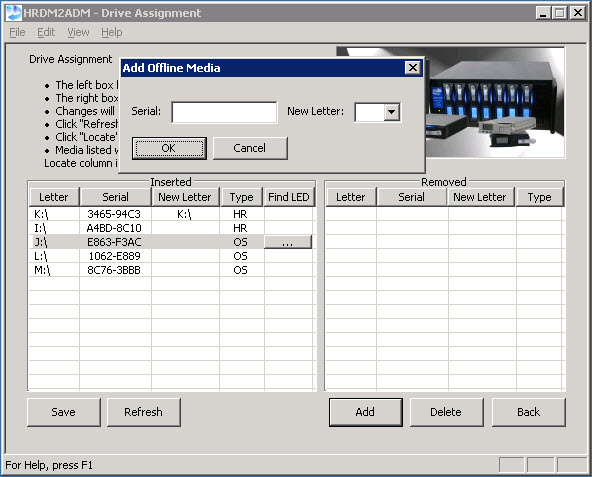Hi-Rely RAIDFrame: External Disk-To-Disk Backup Via eSATA
High-Rely Drive Manager 2.2
Highly Reliable also provided the High-Rely Drive Manager utility with our hardware setup. This software utility helps solve the problem of Windows assigning the first available drive letter to a newly-attached disk drive. Without this solution, this automatic disk assignment would present itself as a problem if you needed to move or replace drive letter-assigned RAIDPacs amongst the drive bays in the RAIDFrame chassis.
The HR Drive Manager is a GUI-based configuration tool that gives the user an interface to edit the HRDM2.ini file and restart the back-end Windows service that maintains the updated configuration. All you need is the Windows generated Volume Serial Number for the drive you want to assign the drive letter to. In order to get the serial number, you need to go to the Windows command line interface and run the “dir” command on the drive you want Drive Manager to manage. You’ll see the Volume Serial Number right below the volume label.
My only complaint about using the HR Drive Manager was the lack of instructions on how it works. I didn’t get any supporting documentation, but after some tinkering around, I was able to configure the RAIDPacs and assign letters to them. The help file was a little useful; however I relied on my own experience with earlier versions of the HR Drive Manager to figure the interface out.
Also, if you want to get around the GUI, you can also manually update the HRDM2.ini file and restart the HR service. This direct method was used in the earlier version of the other Highly Reliable product I reviewed in 2007.
To test and confirm that the Drive Manager software works in keeping my assigned drive letters, I swapped around the first and third RAIDPacs and placed them in different bays for good measure. As expected, the drives letters assigned to each RAIDPac stayed the same and no letter reassignment was needed.
Get Tom's Hardware's best news and in-depth reviews, straight to your inbox.
-
yyrkoon Perhaps I missed something, But I am curious as to how they got 3 drives per port on the port multiplier. I am familiar with port multipliers, but not the technology they use here apparently.Reply
Also, on a side note, I think this device would be more useful if it allowed you to run RAID 10, but with two out ports. Perhaps even multilane would be in order in this case ? -
yyrkoon Let me clarify what I said above. I feel the device would be "better" if they allowed it to be configured to run RAID 10 using two RAIDPacks.Reply -
jeffunit Nice hardware, but a bit spendy. My software based raid 5 array has higher performance over gigabit ethernet, uses commodity parts, and is much cheaper. I am sure my array costs well under $1000 with 8 750gb drives. Since I am using supermicro hot swap sata drive cages, all I have to do is press a button and the drive comes out. 4 screws, and the drive is removed. Takes well under 5 minutes to remove a drive and put in a new one, and it just takes a philips screwdriver.Reply
And why are there two 450w power supplies? Even if the box is full, that is 30 watts per drive, which is a crazy amount of power. If they stagger the drive spin up, they would never need more than 225w tops.
-
climber This should be a 6Gb/s SATA 3.0 design with port multipliers. If you wanted to back up serious amounts of data to this thing you'd never finish, it would always be in backup mode.Reply -
so if one of the three drives should fail inside a RAIDpac, you have to eject the whole RAIDpac to replace that drive?Reply
That sets the RAID offline ... a RAID 5 should be allow hotswapping a failed disk.
And two PSU but not redundant ? ... doens't seem very HIGH RELIABLE -
thehighrelyguy Although some of these points were mentioned in the article, not being on the front page, these important features may have been missed by a few readers and may answer some of your questions.Reply
1. Each RAID pack has an integrated RAID 5 / RAID 0 controller. This means the RAIDPACs can operate completely standalone without the addition of any special controllers or driver software. Thus, left with nothing but a RAIDPac, you could connect it via eSATA to your motherboard and restore the data.
2. The RAIDpacs use standard SATA hard drives. At present, 2.0TB drives are available making the available capacities 4TB in RAID 5 and 6TB in RAID 0 per RAID pack.
3. There is also a 1 bay RAIDFrame available which can use RAIDPacs interchangeably with the 5 Bay if necessary. The one bay has both ESATA and USB connections for portability and ease of connection. The one bay is substantially cheaper than the 5 bay.
4. The dual ATX power supplies were chosen over specialty redundant power supplies because they are the most widely available power supply in the world making field service for this unit in the dead of the night, practical. The 1 bay has this same feature. By using two instead of one, if a power supply dies, you're not dead, the unit is still usable although some bays may not function.
-
thehighrelyguy yyrkoonPerhaps I missed something, But I am curious as to how they got 3 drives per port on the port multiplier. The RAIDFrame is not a single RAID system. The RAIDFrame 5 bay is 5 RAID systems. Each hot swappable RAIDPac is a volume. Port multipliers allow up to 5 volumes (drives) to one SATA channel. Hence one SATA channel, 5 RAIDPacs.Reply


